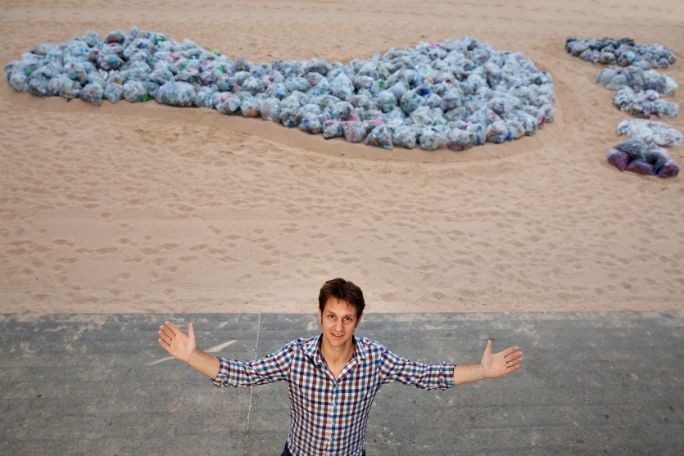Lesson summary
Students explore the issue of single-use plastics and their impact on our environment. They begin by defining the term and exploring examples of single-use plastics before looking at how and why single-use plastics often end up as litter. Students watch and reflect on a clip from War On Waste, then plan and conduct a litter survey of their school yard to determine the types of single-use plastics that are most commonly littered at their school. Students then work collaboratively to communicate their findings.
Learning intentions:
Students will...
- understand what single-use plastics are and why they are a problem for our environment
- recognise that single-use plastics are a common form of litter, even at their own school.
Success criteria:
Students can...
- make and record observations using tally marks
- use and create simple maps
- communicate survey results through charts, graphs or tables
- participate in class discussions
- work collaboratively.
Lesson guides and printables
Curriculum links
Select your curriculum from the options below.
Lesson details
Curriculum mapping
Australian curriculum content descriptions:
Foundation HASS:
- Collect data and information from observations and identify information and data from sources provided (ACHASSI002)
- Sort and record information and data, including location, in tables and on plans and labelled maps (ACHASSI003)
- Draw simple conclusions based on discussions, observations and information displayed in pictures and texts and on maps (ACHASSI008)
- Reflect on learning to propose how to care for places and sites that are important or significant (ACHASSI009)
Year 1 HASS:
- Collect data and information from observations and identify information and data from sources provided (ACHASSI019)
- Sort and record information and data, including location, in tables and on plans and labelled maps (ACHASSI020)
- Draw simple conclusions based on discussions, observations and information displayed in pictures and texts and on maps (ACHASSI025)
- Reflect on learning to propose how to care for places and sites that are important or significant (ACHASSI026)
Year 2 HASS:
- Collect data and information from observations and identify information and data from sources provided (ACHASSI035)
- Sort and record information and data, including location, in tables and on plans and labelled maps (ACHASSI036)
- Draw simple conclusions based on discussions, observations and information displayed in pictures and texts and on maps (ACHASSI041)
- Reflect on learning to propose how to care for places and sites that are important or significant (ACHASSI042)
Year 3 HASS:
- Locate and collect information and data from different sources, including observations (ACHASSI053)
- Record, sort and represent data and the location of places and their characteristics in different formats, including simple graphs, tables and maps, using discipline-appropriate conventions (ACHASSI054)
- Draw simple conclusions based on analysis of information and data (ACHASSI058)
- Reflect on learning to propose actions in response to an issue or challenge and consider possible effects of proposed actions (ACHASSI060)
Syllabus outcomes: GEe-2, GE1-3, GE2-4
General capabilities: Critical and Creative Thinking
Cross-curriculum priority: Sustainability OI.7, OI.8
Relevant parts of Foundation HASS achievement standards: Students observe the familiar features of places and represent these features and their location on pictorial maps and models. They reflect on their learning to suggest ways they can care for a familiar place.
Relevant parts of Year 1 HASS achievement standards: Students collect and interpret information and data from observations. They represent the location of different places and their features on labelled maps. They reflect on their learning to suggest ways they can care for places.
Relevant parts of Year 2 HASS achievement standards: Students locate information from observations and from sources provided. They sort and record data in tables, plans and on labelled maps. They reflect on their learning to suggest ways to care for places and sites of significance.
Relevant parts of Year 3 HASS achievement standards: Students locate and collect information from sources, including observations. They record and represent data in different formats, including labelled maps using basic cartographic conventions. They reflect on their learning to suggest individual action in response to an issue or challenge.
Topic: Waste, sustainability
This lesson is part of the wider unit of work: War On Waste – Foundation to Year 3
Time required: 60+ mins
Level of teacher scaffolding: High – lead students in discussions, support and lead students in litter survey
Resources required
- Camera or device capable of taking photos, such as a tablet or phone
- Device capable of presenting an online clip to the class
- Litter Data Sheet
- Reflection Worksheet
- Single-use Plastics Flashcards
- Student Worksheet – one per student (optional)
Skills
This lesson is designed to build students’ competencies in the following skills:
- Communication
- Collaboration
- Critical thinking
Additional info
Cool Australia’s War On Waste lessons have been developed in partnership with Lune Media and with support from the Australian Environmental Grantmakers Network. These lessons have been designed to lead students through a deeper understanding of some of the big issues relating to waste in Australia and to support them to take action to reduce the impact of waste on our environment.


Welcome back!
Don't have an account yet?
Log in with:
Create your free Cool.org account.
Many of our resources are free, with an option to upgrade to Cool+ for premium content.
Already have an account?
Sign up with:
By signing up you accept Cool.org's Terms and Conditions(Opens in new tab) and Privacy Policy(Opens in new tab).